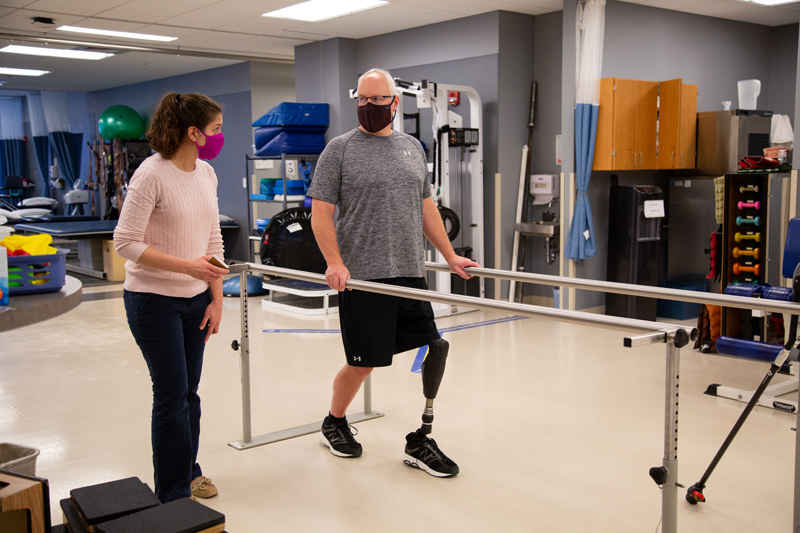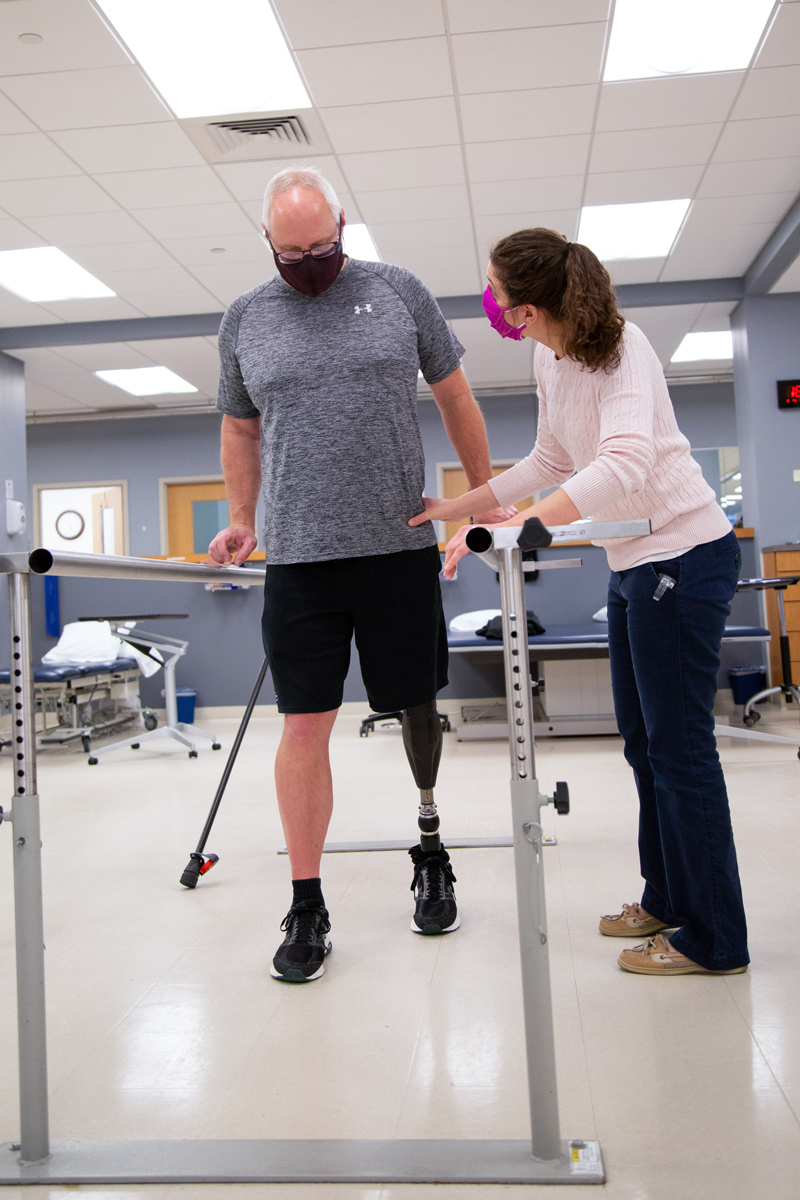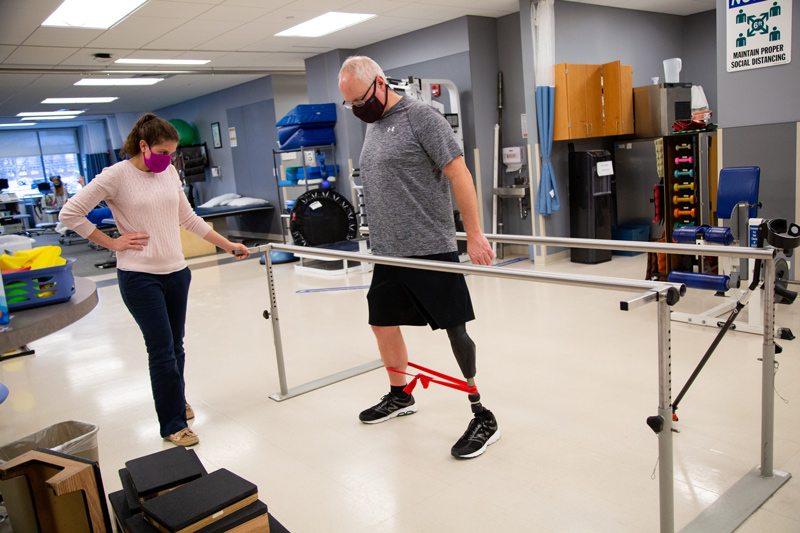

Glenn Runyon’s left leg was amputated in 2015 following a diagnosis of malignant sarcoma behind his knee. While doing research before his amputation surgery, Runyon heard about another prosthetic option. Osseointegration is the name for the surgical approach.: youtube.com/watch?v=eIbI_1gqGfE
Making strides
Photos and video by Ashley Barnas May 11, 2021
UD PT Clinic helps man get back on his feet after osseointegration surgery
Glenn Runyon’s hands graze the parallel bars in the University of Delaware Physical Therapy Clinic as he walks the length of the metal rails without the assistance of his cane. To a casual observer, Runyon’s strides seem remarkably proficient for someone who underwent two surgeries to insert a titanium rod on his left leg to anchor a prosthetic limb.
But Sarah Smith, a staff physical therapist at the clinic, watches Runyon with a more critical eye. She notices that he leans forward slightly as he walks. As he takes his next step. Smith places her hand on his left hip. Runyon’s posture changes; his gait smoothes out.
Over the next 30 minutes, Smith takes Runyon through squats, lunges and other exercises to put weight on his left leg, the one with the metal prosthesis that Runyon controls with an app on his phone.

By the end of the appointment, his gray t-shirt bears the sweat-stained marks of his effort. Still, the Concord High School social studies teacher and assistant football coach manages a smile and a few self-deprecating wisecracks with Smith, who notes his increased strength and ability to bear weight on his left leg.
“Any pain?” she asks.
“Nope, just resting,” he says. “We’re going in the right direction.”
Considering prosthetic options
Runyon’s left leg was amputated in 2015 following a diagnosis of malignant sarcoma behind his knee. The surgery left him with a relatively small residual limb after the amputation, which made it hard to get a good fit with a prosthetic socket, the traditional way a prosthesis attaches to the body.
“Imagine every day that your foot can be in a different spot. How hard would it be to walk? That's what you go through with a prosthetic,” Runyon said. “Then, coaching football in August, during two-a-days, it's 100 degrees out, my leg would be almost baking in there, it was so hot. I would keep an extra towel in the freezer just to cool myself down.”
While doing research before his amputation surgery, Runyon heard about another prosthetic option. Osseointegration is the name for a surgical approach that connects a prosthesis directly to the bone in the amputated limb. (The same approach is used for dental implants.)

The procedure involves implanting a titanium rod directly into the bone. The rod extends out of the residual limb, allowing a prosthesis to be attached. It can be an option for patients who have not been successful with conventional socket prostheses.
Although the technique has been around for a couple decades, it is still a rarity in the United States, said John Horne, owner of Independence Prosthetics Orthotics, who has helped Runyon since his amputation. Horne estimates there are only about 100 people in the U.S. and 1,000 in the world who have undergone osseointegration after lower-limb amputation.
“With the integration into the bone, there are certain activities that are not recommended, such as high impact sports that can have an impact on the bone. Otherwise, normal activities of daily living are not compromised,” Horne said. “It's the freedom for the patient not to have to wear the socket around their body.”
A new direction
Runyon underwent osseointegration last year at Johns Hopkins University. The two-surgery process requires time in between to allow the bone to heal and connect with the metal implant. Because of the COVID pandemic, the wait time between the surgeries was longer than usual — almost nine months rather than the expected three — but it was worth it.
Weekly visits to the UD PT Clinic help Runyon improve his balance, increase his walking speed and strengthen the muscles he uses in his other daily activities. During his sessions, Runyon stands on a balance board, adjusting his legs as it rocks back and forth. He slides a resistance band around his legs to practice sidestepping, all while Smith peppers him with questions and commands to move.
“You let me know if this is too much for you, OK?” Smith tells him after two rounds of lunges and squats.
“I’m not feeling it like I did last time,” Runyon tells her.

Although Smith regularly sees patients with lower-limb amputations, Runyon is the first to have osseointegration. She remains in frequent contact with Runyon’s surgeon, Dr. Jonathan Forsberg, as well as Horne and the staff at Independence, to make sure she’s addressing any issues that are unique to osseointegration patients.
“There's a connector piece that actually runs through his bone so now he can feel much more when he's walking. We call it proprioception, so when he hits down he can feel his heel on the ground,” said Smith, who has been working with Runyon for five years, starting after his amputation. “We have to watch out in terms of progression of exercise. He might not feel pain right then but he can feel it later on.”
Runyon keeps his cell phone in his pocket to make adjustments to his prosthetic leg as needed. He makes a joke out of twisting his prosthesis in unusual positions, but the predictability of the artificial limb is a welcome change after the past few years.
Now that he’s feeling stronger, he hopes to return to the football field. He wants to use his own experiences to help athletes maintain control of challenging situations.
“Is my life exactly like it was before? Of course not, but I think of things as challenges,” he said. “I have to find a new way to do whatever it is I do. And sometimes I can do it. And sometimes I can't do it. And that's just frustrating - there's no doubt about it. But it's nice to be able to problem solve and see if I can adapt.”
Contact Us
Have a UDaily story idea?
Contact us at ocm@udel.edu
Members of the press
Contact us at 302-831-NEWS or visit the Media Relations website

